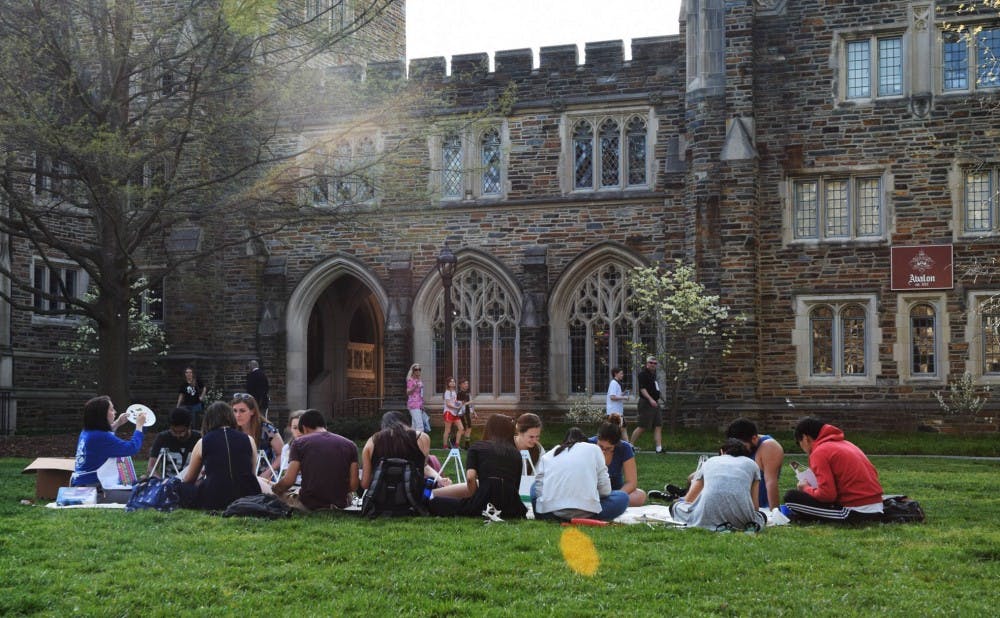As with many aspects of life at Duke, wealth disparities play a role in shaping students’ experiences in the arts and humanities.
For some students, the arts and humanities at Duke are not inclusive to low-income students and students of color. Faculty and students in these fields are working to overcome the problem, taking steps to build communities that are open to people from all backgrounds.
Junior Jamal Burns, a history major and co-president of Duke Low-Income, First-Generation Engagement, said the material taught in some courses could turn students away.
“Students are continually dissuaded from taking these classes because they get a syllabus that shows only white authors, only authors who are wealthy or went to elite institutions,” he said.
Senior Naomi Lilly, an African and African American studies and gender studies double major, said students of color may face a burden in these courses. She said she is often the only person of color in a class, and it is on her shoulders to “explain the history that is not there, not talked about or glanced over,” she said.
Although Duke poured $50 million into building the Rubenstein Arts Center, this does not equate to providing support for students, Lilly said. She said she has experienced difficulty in getting financial and academic support from the University to pursue her projects in the arts.
One of Duke’s recent efforts to build opportunity in the arts, DEMAN weekend, is an arts alumni networking event to help introduce students into the creative industry. However, at her first DEMAN weekend, Lilly said she was disappointed by the panels.
“Most people had this story that when you get to Hollywood, you just have to work in the mail room and sleep in someone’s garage,” Lilly said. “Realistically, that’s not the experience for everyone, especially people of color, especially if you come from a lower socio-economic status.”
Bridging the gap
Some students and faculty members are attempting to fill gaps in students’ experiences at Duke.
Scott Lindroth, vice provost of the arts, wrote in an email that Duke Arts, ranging from music to theater studies, is also trying to adapt to Duke’s changing demographics.
“My colleagues in the arts also acknowledge that some students, including first-generation, low-income, or minority students, may face additional challenges to participation that are unique to the arts—and we have designed specific funding resources and programs to address this,” he wrote.
Funding opportunities such as the Creative Arts Grants and Benenson Awards exist to support student projects, while the Black Atlantic festival and the Documentary Diversity Project are geared toward diversifying the arts field. Lindroth stated that Duke Arts aims to provide networks for students of all backgrounds.
Within the English department, several efforts have been made to build community. Every third Thursday of the month, the English department invites prospective and current English students to join the faculty for an afternoon of desserts.
Inspired by a similar desire to build an equitable arts community, Della Tao, Trinity ‘19, and senior Joyce Er created a series of weekly figure-drawing workshops that otherwise would not be accessible to students. Er said such programs often cost $10 to $12 per session, up to $100 for 10 weeks.
“A fifth of our participants had no prior visual arts experience, but were able to drop in, pick up a piece of charcoal and begin learning the ropes,” Er said.
Lilly is building a networking site for creatives, hoping to provide more opportunities in industry for the voices that most need to be heard. The online platform, NAL-Nay Lilly, “amplifies the voices of marginalized creatives within the entertainment and media industries,” she said in an interview with Duke Arts.
Part of the reason she wanted to make this company is to help create a pipeline to an arts career, which she has never had.
These efforts have attempted to build an arts and humanities community on Duke’s campus that are inclusive to all backgrounds.
Yet Lilly said she believes that Duke still has a long way to go.
“I think Duke, in a lot of ways, supports the idea that when you come to Duke, arts is a hobby—it’s not a career,” she said. “I think really changing that mindset as far as the networking events, as far as being intentional about the companies that come, as far as being intentional about resume drop-offs interviews is critical.”
This article is part of the wealth gap series. We are exploring how wealth impacts the student experience. Read about the project and explore the rest of the series.
Get The Chronicle straight to your inbox
Signup for our weekly newsletter. Cancel at any time.

